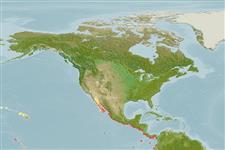>
Carangaria/misc (Various families in series Carangaria) >
Centropomidae (Snooks)
Etymology: Centropomus: Greek, kentron = sting + Greek, poma, -atos = cover, operculum (Ref. 45335).
More on author: Günther.
Environment: milieu / climate zone / depth range / distribution range
Ecologia
marinhas; Água doce; estuarina demersal. Tropical; 29°N - 0°N, 113°W - 77°W
Eastern Pacific: southwestern coast of Baja California Sur, Mexico and the central Gulf of California to Ecuador.
Tamanho / Peso / Idade
Maturity: Lm ? range ? - ? cm
Max length : 65.0 cm TL macho/indeterminado; (Ref. 55763); common length : 30.0 cm TL macho/indeterminado; (Ref. 55763); peso máx. Publicado: 3.2 kg (Ref. 40637)
Body slender and not very deep; dorsal profile slightly concave behind the eyes; lateral line extending to posterior edge of caudal fin; second anal spine, when folded down, not reaching origin of caudal fin; pectoral fins shorter than pelvic fins; anal fin with 7 rays; back blue or gray; belly silvery; lateral line dark. Membranes between second and third anal spines black; distal quarter of pelvic fins generally dark (Ref. 55763).
Adults inhabit bays and estuaries (Ref. 37955). Also found in high altitudes of at least 250 m elevation and a distance of some 20 km from the coast. They also occur in coastal waters, but is more abundant in estuaries of any size. Enter freshwaters mostly in large rivers and feeds on fish and crustaceans (Ref. 36880).
Life cycle and mating behavior
Maturidade | Reprodução | Desova | Ovos | Fecundidade | Larvas
Bussing, W.A., 1995. Centropomidae. Róbalos. p. 987-995. In W. Fischer, F. Krupp, W. Schneider, C. Sommer, K.E. Carpenter and V. Niem (eds.) Guia FAO para Identification de Especies para lo Fines de la Pesca. Pacifico Centro-Oriental. 3 Vols. FAO, Rome. (Ref. 9284)
Categoria na Lista Vermelha da IUCN (Ref. 130435)
Ameaça para o homem
Harmless
Utilização humana
Pescarias: espécies comerciais; peixe desportivo: sim
Mais informação
Nomes comunsSinónimosMetabolismoPredadoresEcotoxicologiaReproduçãoMaturidadeDesovaAgregação para desovaFecundidadeOvosDesenvolvimento dos ovos
ReferênciasAquaculturaPerfil para aquaculturaEstirpesGenéticaElectrophoresesHereditariedadeDoençasProcessamentoNutrientsMass conversion
ColaboradoresFotografiasStamps, Coins Misc.SonsCiguateraVelocidadeTipo de nataçãoÁrea branquialOutras referênciasCérebrosVisão
Ferramentas
Relatórios especiais
Descarregue XML
Fontes da internet
Estimates based on models
Preferred temperature (Ref.
123201): 23.3 - 28.6, mean 27.5 °C (based on 36 cells).
Phylogenetic diversity index (Ref.
82804): PD
50 = 0.5005 [Uniqueness, from 0.5 = low to 2.0 = high].
Bayesian length-weight: a=0.00741 (0.00464 - 0.01185), b=3.04 (2.90 - 3.18), in cm total length, based on LWR estimates for this species & Genus-body shape (Ref.
93245).
Nível Trófico (Ref.
69278): 4.0 ±0.65 se; based on food items.
Resiliência (Ref.
120179): Médio, tempo mínimo de duplicação da população 1,4 - 4,4 anos (Preliminary K or Fecundity.).
Fishing Vulnerability (Ref.
59153): Moderate to high vulnerability (46 of 100).
Nutrients (Ref.
124155): Calcium = 128 [73, 204] mg/100g; Iron = 1.09 [0.73, 1.62] mg/100g; Protein = 19.5 [17.2, 21.7] %; Omega3 = 0.255 [0.116, 0.568] g/100g; Selenium = 48.6 [27.0, 89.8] μg/100g; VitaminA = 12.2 [5.1, 28.0] μg/100g; Zinc = 1.06 [0.81, 1.42] mg/100g (wet weight);
